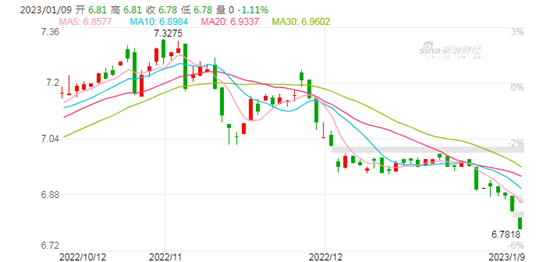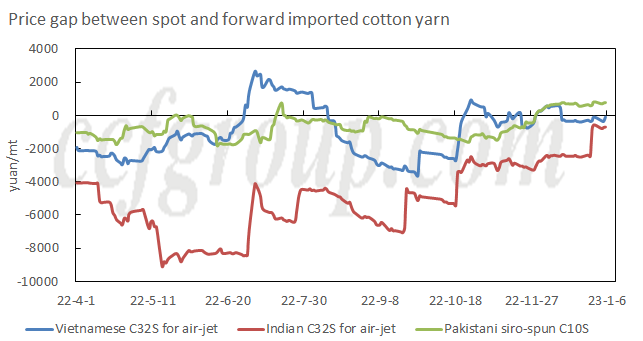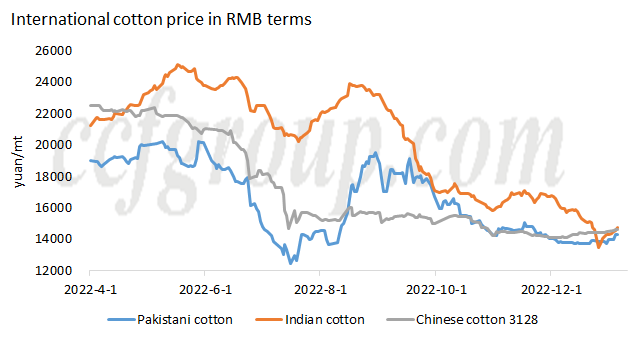Could imported cotton yarn take the tail wind of RMB appreciation?
Cotton and cotton yarn market was astonished by the news that the onshore and offshore RMB continued to pull up and both rose above 6.80 recently. This round of appreciation began from Nov and in Dec gradually stabilized to the same level of last Aug, with a reasonable fluctuation. The fall of exchange rate prompted the recovery of cotton yarn procurement and stock, particularly for South East Asian yarn mills. Indian yarn mills had suffered high domestic cotton price for a while and was now able to lift their O/R to above 50%.

Source: Sina Finance
Mainstream opinions contributed the fast appreciation of RMB to several factors, including the gradual recovery of China’s domestic economy, which re-attracted foreign capital, and the seasonal exchange settlement. Most foreign trade firms would increase exchange settlement in fourth quarter, according to an import-export trade company, who got receipts of its exported cotton yarn and clothing fabrics during high exchange settlement but still had to deal with the emerging requirements of exchange settlement caused by year end payment of goods and settlement of salary and bonus. And together with the relatively loose supply of USD in domestic exchange market, RMB was able to go up. Besides, China’s State Administration of Foreign Exchange prolonged exchange trading time to 3:00am helped in some extent prevent the short selling of RMB by foreign speculative capitals. A stabilized exchange rate lowered the requirement of risk control during the process of cotton yarn import and benefited operating profit lock-in.
Ordering profit turned better
Many booed after several occasions of low ordering but high exchange settlement this year. The lowering price of imported cotton yarn also caused a sharp shrinkage of operating capacity in the second half of the yeard. After entering into Dec the exchange rate fell and became stabilized, getting the imported cotton yarn out of the trouble of months-long loss and see significant improvement of operating profit. As can be seen in charters below, most of early-to-mid Dec arrivals were ordered at the end of Oct, when ICE cotton futures fell low and exchange rate hit high. Such a great pressure for ordering got relived and ordering profit began to rise significantly only after USD dropped and actual exchange settlement cost reduced.
| Products | Ordering price | Exchange rate when order | Cost when order | Exchange settlement in Dec | Actual cost | Selling price | Profit(yuan/mt) |
| Vietnamese OEC10S | 1.95 | 7.28 | 16300 | 7.05 | 15900 | 16500 | 600 |
| VietnameseOEC21S | 2.2 | 7.28 | 18400 | 7.08 | 17900 | 18700 | 800 |
| Vietnamesec32S for knitting, contamination controlled | 2.85 | 7.3 | 23800 | 7.05 | 23000 | 25000 | 2000 |
| Vietnamese C21S for weaving, contamination controlled | 2.6 | 7.28 | 21680 | 7.05 | 21000 | 22000 | 1000 |
Vietnamese, Indian and Pakistani cotton yarn saw a narrowed gap between foreign and domestic price and profits of spot order came back to be positive in Jan. Pakistani siro-spun yarn had a spot profit of near 1,500yuan/mt. Its profit was expected to remain high even if the spot offer dropped after supply increased later. Indian carded yarn is still higher than the price in China local market, while the combed yarn of almost the same ordering price took the lead in gaining profit, and the procurement in China also increased recently.

A narrowed price gap with domestic cotton yarn
The risk of ordering imported cotton yarn gradually diminished after a reduced gap between imported and domestic cotton yarn. Domestic cotton yarn price has experienced waves of rise during the course of year end stock-up. As shown in chart below, mainstream ring-spun C32S and open-end or siro-spun yarn was offered at similar level. Still it is too early for imported cotton yarn to remove its highly priced label. Besides, it would also take downstream weaving mills some time to alter current consumption habit. Therefore low-cost imported cotton yarn could not avoid sales pressure when arrived after Spring Festival. Indian cotton price temporally dropped to 13,500yuan/mt and then rose to 14,700yuan/mt, stronger than ZCE cotton futures. Pakistani cotton fluctuated at around 14,000yuan/mt. Whether imported cotton yarn could regain price advantage would be decided by future trend of the price gap. Indian yarn would likely to become the dark horse if Indian cotton supply increases sand its price drops further.
| Products | Price(yuan/mt) |
| CY32S high-grade | 22800-23000 |
| Vietnamese C32S for air-jet, contamination controlled | 23000-23200 |
| Indian C32S for air-jet, contamination controlled | 23000 |
| China OE16S for air-jet | 17800-18000 |
| Vietnamese OEC 16S for air-jet, contamination controlled | 18000-18500 |
| China siro-spun 10S | 21500-21800 |
| Imported second-line Pakistani Siro-spun 10S | 21500 |

In summary, the profit of imported cotton yarn relied not only on exchange rate, but also on domestic demand, as well as its own price advantage. It may too early to expect RMB enter into the fast track in short-term as Fed warned public not to read too much into the slowing process of interest raise and a high interest rate could maintain for a while. For imported cotton yarn there’d be new opportunities and challenges as a large amount of low-priced imported yarn is expected to arrive after Spring Festival.
- Top keywords
- Cotton Price
- Cotton Futures Price
- Cotton Futures
- CZCE
- PTA Futures Price
- Chemical Fiber
- Polyester Prices
- Wool price
- PTA Futures
- Shengze Silk
- China
- Yarn Price
- price
- China Textile City
- Fibre Price
- Benzene Price
- Cotton
- Index
- Cotton Index
- PTA
- fabric price
- NYMEX
- Top 10
- textile industry
- Spot Cotton
- Cotton Yarn
- Polyester Price
- Futures
- PTA Price
- cotton yarn price

